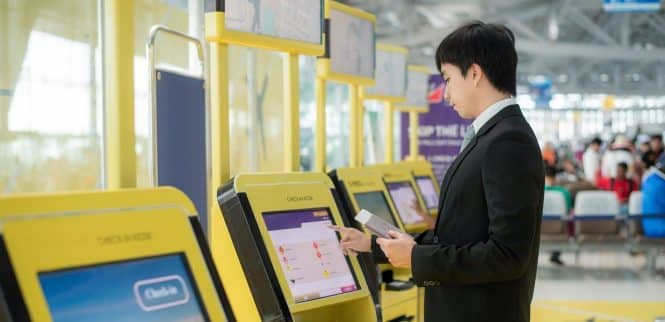
3 Ways to Set Up a Successful Kiosk Implementation in 2020
Editors Note: good advice from StarMicronics. Too often poor components and inexperienced provider kill a perfectly reasonable kiosk project. And location is definitely important. We would add making it easy for employees to do routine servicing and paper replenishments.
So, you’re looking to take advantage of self-service kiosk technology. You know that self-service solutions can boost profits, increase order accuracy, and improve the customer experience. But how do you ensure a successful kiosk implementation?
First and foremost, it’s important to remember that understanding the environment in which the self-service kiosk will operate is crucial to its success. If the kiosk will remain unattended for the most part of its operational cycle and if attending it for any reason (being it technical or merely operational) is costly due to distances or any other logistic aspect, then focusing on the kiosk’s autonomy is key.
Explore Star’s self-service kiosk solutions.
Your best chance for an autonomous kiosk boils down to three important factors:
- A powerful and effective set of components
- A strategic location, and
- A high-quality supplier.
Read on to learn more about each factor.
Kiosk Implementation Rule #1: A Kiosk is as Powerful and Effective as the Sum of its Components
For any kiosk integrator, selecting the proper components when putting together a kiosk solution is one of the most important aspects of their kiosk design. Three things to look for when selecting kiosk components are ruggedness, a large paper roll holder, and user-proof features.
- Ruggedness: A good rule of thumb is to make sure the kiosk printer that you select is durable and includes components that are long-lasting. In terms of a kiosk printer, that includes consumables such as the print head, automatic cutter, and more.
- Large Paper Roll Holder: One easy way to instantly cut down on maintenance time (and associated fees) is by selecting a large paper roll holder for your kiosk. Considering a larger paper roll diameter (length) allows the kiosk to operate for a longer period of time without attention since it can accommodate many more printed receipts without any additional paper roll changes.
- User–Proof Features: Designing a kiosk to be user-proof is very important. What exactly does user-proof mean? It means creating a self-service solution which process is inherently straightforward and easy-to-adopt for end-users. One way to do that is by considering the use of an optional presenter to allow all the printing and cutting to happen inside the kiosk unit prior to making it available to the user. With a presenter, there’s no question about whether or not the receipt is ready.
Choosing the right technology in your self-service solution allows your kiosk to be remotely monitored, so that operators can more effectively and efficiently plan maintenance visits regarding paper replenishing, technical service, replacement of consumable components, etc. At the end of the day, this efficiency means less downtime, more profit, and happier customers!
Kiosk Implementation Rule #2: Location, Location, Location
You know what they say: location is key! That same rule applies to self-service kiosks.
Selecting the right place for your self-service kiosk solution not only can increase sales, but may also affect its reliability, durability, and customers’ perceptions of quality of service provided.
A couple of tips for choosing a location include:
- Consider an easy-to-access, well-illuminated, and high-traffic area to give your kiosk the greatest chance for success in terms of adoption and sales.
- Make sure that when you select the kiosk’s location, you are considering how the location will benefit or affect both the end-user and the kiosk’s success. For example, if your kiosk is serving as a parking self-service payment station, it should be placed in a natural path towards the parking garage to allow end-users to access it without having to go to a different area or being unsure of where to pay.
Kiosk Implementation Rule #3: Your Supplier Matters
Last but not least, your supplier matters … a lot. In order to choose a supplier that will be able to assist you in the long run no matter what your use case, be sure to go with one that acts as a trusted adviser, offers a wide range of kiosk printers, and provides top-notch support.
- A Trusted Adviser: Choosing a supplier that doesn’t just sell, but consults, is just as important as selecting your kiosk’s components and location. To do this, look for a manufacturer with a healthy amount of industry experience who can act as a trusted adviser. Working with companies specialized in the vertical being attended, in this case the self-service kiosk vertical, is critical. Absorbing decades of experience and having access to the most innovative technologies and options will benefit your final solution, and in some cases will open the door to create solutions previously inconceivable.
- A Wide Range of Kiosk Printers: Kiosks are not “one size fits all.” Choose a supplier that offers a range of kiosk printers, including open-frame and closed-frame, with a variety of possible positions, connectivity options, and accessories.
- Superb Support: Your self-service journey doesn’t end when the kiosk implementation is complete. Your long-term success depends on choosing a supplier that offers a robust level of support, such as easy-to-find drivers, manuals, warranty information, and FAQs/troubleshooting, as well as on-site technical support staff.
We hope that these kiosk implementation tips were helpful, and will guide you as you select kiosk components, locations and use cases, and suppliers.



